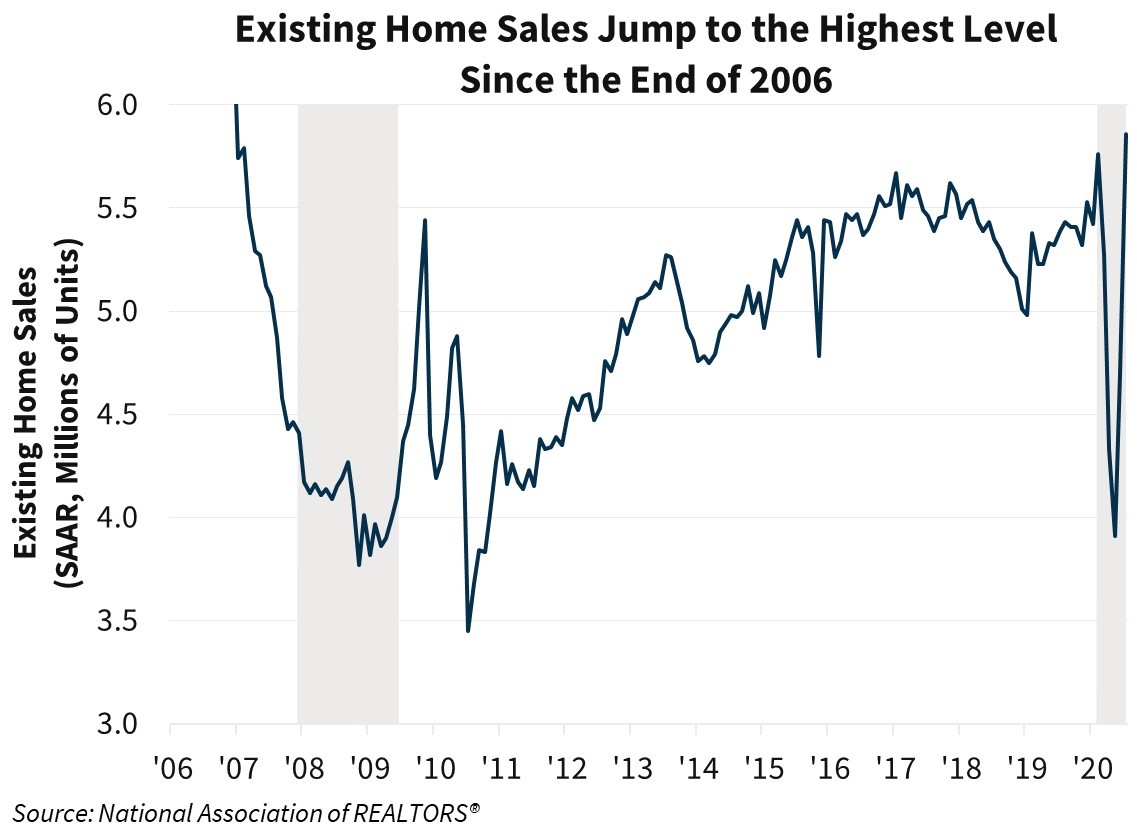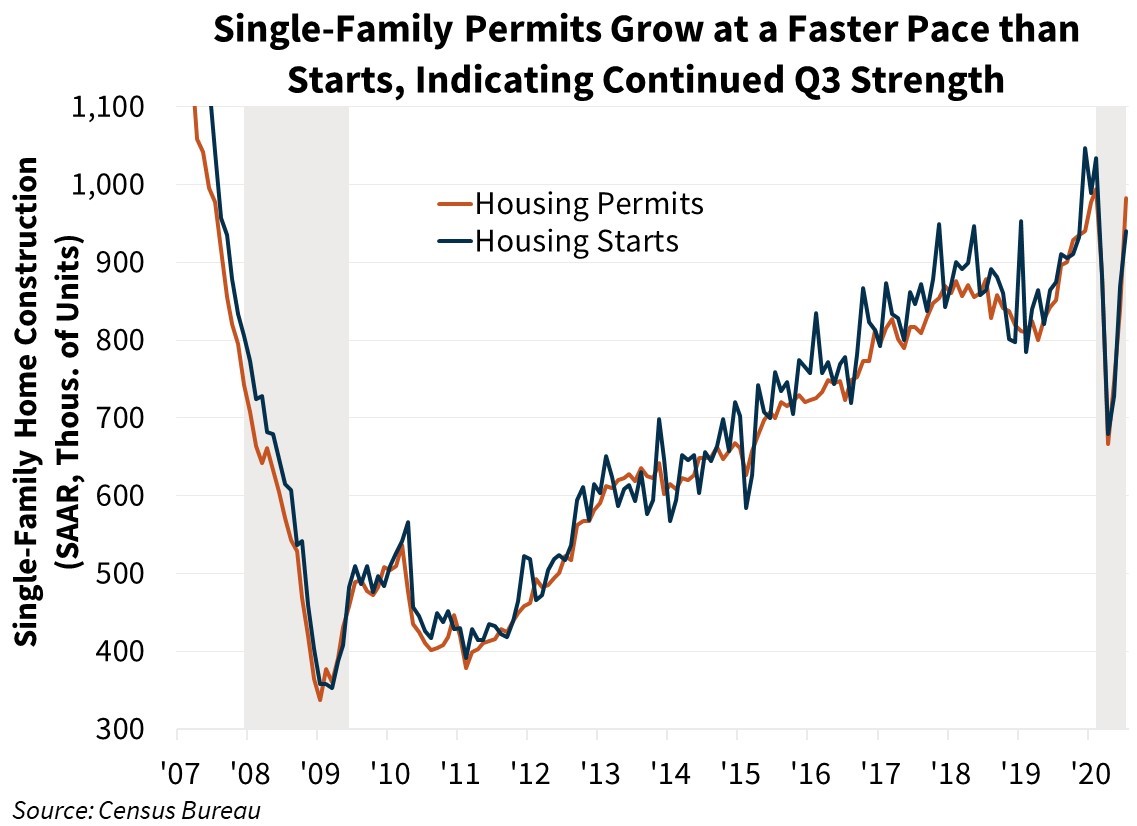Housing Activity Continues Its Upward Climb
Key Takeaways:
- The Conference Board Leading Economic Index (LEI), a gauge of the economic outlook over the next three to six months, rose 1.4 percent in July, the third consecutive monthly increase. However, it remained 6.8 percent below its January reading and weakness among the leading indicators was widespread. According to the press release, “the initial post-pandemic recovery appears to be losing steam,” suggesting that the pace of economic growth will slow substantially during the final months of the year from the recovery seen over May and June.
- Existing home sales soared 24.7 percent in July, the second straight month of over 20 percent growth, to a seasonally adjusted annualized rate of 5.86 million units, according to the National Association of REALTORS®. Despite this impressive growth, year to date, total existing home sales were still down 4.4 percent from the same time a year ago. Sales posted double-digit gains in every region. The number of homes for sale (not seasonally adjusted) fell 21.1 percent year over year, the fourteenth consecutive month of declining inventories. The months’ supply was 3.1 months, which is the lowest July reading since the survey began in 1999 and near the all-time low of 3.0 months. The median sales price rose 8.5 percent on an annual basis, the fastest pace of growth in over five years, and the national median home price increased above $300,000 for the first time (not adjusted for inflation). Homes were selling fast, as properties typically stayed on the market for only 22 days in July and 68 percent of homes sold were on the market for less than a month.
- Housing starts increased for the third consecutive month in July, rising 22.6 percent to 1.50 million annualized units, according to the Census Bureau. Revisions to the prior two months added over 60,000 units to total starts. While single-family starts rose a solid 8.2 percent, the more volatile multifamily starts series jumped 58.4 percent, rising to the highest level since January. On a year-to-date basis, single-family construction was up nearly a full percentage point from the same time last year and multifamily construction was 13.6 percent above year-ago levels.
- The National Association of Home Builders/Wells Fargo Housing Market Index rose 6 points in August to 78, the highest level since 1998. A reading above 50 indicates that more builders view the single-family market as “good” rather than “poor.” The present sales component and sales in the next six months component fully recovered from the declines seen in the second quarter and the traffic of prospective buyers component surged to a record high. According to the press release, “The demand for new single-family homes continues to be strong; however, the V-shaped recovery has produced a staggering increase in lumber prices…[which] could dampen momentum in the housing market this fall.”
- The Mortgage Bankers Association National Delinquency Survey for Q2 2020 showed that the delinquency rate for mortgage loans on one-to-four unit residential properties spiked 3.9 percentage points to a seasonally adjusted rate of 8.2 percent of all loans outstanding. This is the highest delinquency rate in nine years and the largest one-quarter gain since the series began in 1972. However, the survey asked servicers to report loans as delinquent if the payment was not made based on the original terms of the mortgage, meaning many loans in forbearance were counted as delinquent. This contradiction could be seen in the percentage of loans on which foreclosure actions were started, which fell to near-zero (0.03 percent), the lowest level on record. The serious delinquency rate (the percent of loans that are 90 days or more past due or in the process of foreclosure) jumped nearly 280 basis points to 3.72 percent.
Forecast Impact:
ousing data continue to be the bright spot in an economy disrupted by the coronavirus pandemic. July housing starts surpassed our most recent projection made in August, and we will likely have to revise them upward for the fourth straight month in our September forecast. Both single-family and multifamily permits posted double-digit increases in July, suggesting the strong pace of starts will continue through the third quarter. Existing home sales in July had fully recovered from the declines seen early in the second quarter, rising to the highest annualized level since 2006. The increase was in line with our forecast, which has existing home sales rising an impressive 32 percent in the third quarter. Looking past the third quarter, however, we believe supply constraints remain a key downside risk. Existing home sales account for approximately 86 percent of total home sales, and with inventories falling to near all-time lows more homes will have to be built to keep up with intense buyer demand.


Economic and Strategic Research Group
August 21, 2020
Opinions, analyses, estimates, forecasts and other views of Fannie Mae's Economic and Strategic Research (ESR) Group included in these materials should not be construed as indicating Fannie Mae's business prospects or expected results, are based on a number of assumptions, and are subject to change without notice. How this information affects Fannie Mae will depend on many factors. Although the ESR group bases its opinions, analyses, estimates, forecasts and other views on information it considers reliable, it does not guarantee that the information provided in these materials is accurate, current or suitable for any particular purpose. Changes in the assumptions or the information underlying these views, including assumptions about the duration and magnitude of shutdowns and social distancing, could produce materially different results. The analyses, opinions, estimates, forecasts and other views published by the ESR group represent the views of that group as of the date indicated and do not necessarily represent the views of Fannie Mae or its management.
